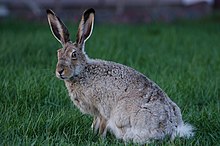White-tailed jackrabbit
| White-tailed jackrabbit | |
|---|---|
 |
|
| Scientific classification | |
| Kingdom: | Animalia |
| Phylum: | Chordata |
| Class: | Mammalia |
| Order: | Lagomorpha |
| Family: | Leporidae |
| Genus: | Lepus |
| Species: | L. townsendii |
| Binomial name | |
|
Lepus townsendii Bachman, 1839 |
|
 |
|
| White-tailed jackrabbit range | |
The white-tailed jackrabbit (Lepus townsendii), also known as the prairie hare and the white jack, is a species of hare found in western North America. Like all hares and rabbits, it is a member of the family Leporidae of order Lagomorpha. It is a solitary individual except where several males court a female in the breeding season. Litters of four to five young are born in a form, a shallow depression in the ground, hidden among vegetation. This jackrabbit has two described subspecies: L. townsendii townsendii occurring west of the Rocky Mountains and L. townsendii campanius occurring east of the Rocky Mountains.
The white-tailed jackrabbit is a large species of hare and the largest species called "jackrabbit", although two larger hares (the Arctic and Alaskan hares) are found further north in North America. This jackrabbit has an adult length of 56 to 65 cm (22 to 26 in), including a tail measuring 6.6 to 10.2 cm (2.6 to 4.0 in), and a weight between 2.5 and 4.3 kg (5.5 and 9.5 lb). From winter to spring, weight tends to increase due to pregnancy in females, but decrease due to the stresses of reproductive competition in males. Thus, females in Iowa went from averaging 3,600 g (7.9 lb) in winter to 3,800 g (8.4 lb) in spring and males from averaging 3,400 g (7.5 lb) in winter to 3,100 g (6.8 lb) in spring. At the northern most extremity of its range, it can be almost twice as large as in the middle of its range. In Saskatchewan, rare specimens have been recorded over 9 kg (20 lb). It has distinctive, large, grey ears with black tips which are chestnut brown and white on the inside; and the long, powerful hind legs characteristic of hares. The back, flanks and limbs are dark brown or greyish-brown and the underparts are pale grey. The ear, from the notch, measures from 10 to 11.3 cm (3.9 to 4.4 in) and the hindfoot measures 14.5 to 16.5 cm (5.7 to 6.5 in). The tail is white with a dark central stripe above. Females are slightly larger than males. In northern populations, this hare moults in the autumn and becomes white all over except for its ears. They generally make no sound, but will emit a shrill scream if they are injured or caught.
...
Wikipedia

